Nokia 7710 – Smartphone Review
Nokia 7710 – Smartphone
With the 7710 Nokia has created a jack of all trades, but is it a master of any of them?
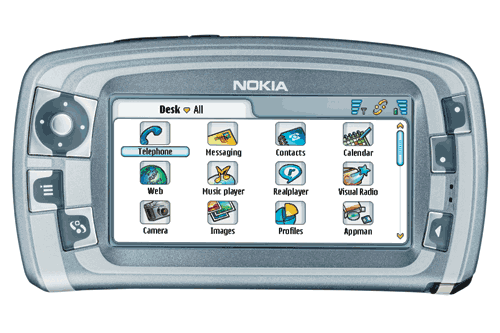
Verdict
Key Specifications
- Review Price: £160.00
Nokia’s 7710 is quite possibly the oddest handsets on the market today. It doesn’t have a number pad, and it looks more like a games console than a phone. This is all part and parcel of the bigger picture with this device, though – it is a true hybrid, and if my days of evaluation tell me nothing else, they shout loud and clear that any company wanting to offer the best of all possible worlds needs to think very carefully indeed about its approach – many times has such a concept been tried without success.
I say this because while the Nokia 7710 has built-in software for business users, for those needing data and voice communications, and for those looking for entertainment, it fails to offer the best experiences; instead having some real highlights and some grave disappointments.

The Nokia 7710 is the first unit to make it to market based on Nokia’s Series 90 platform. This builds on the Series 80 platform found in Nokia’s 9500 Communicator and 9300 Smartphone, but adds touch screen capability. Both Series 80 and Series 90 are built on version 7 of the Symbian operating system. The use of Symbian OS 7 means that Nokia has been able to bundle a huge array of software with the 7710. And it may well be this bundle that is part of the problem. Before I get to the fancy bits, though, I want to consider the staple of any mobile phone – making a voice call.
Despite the fact that the Nokia 7710 doesn’t look like a phone, it is tri-band, and supports GPRS, EGPRS, HSCSD and EDGE. It has no number pad, and its physical design, with buttons at the very top and very bottom of its narrower sides flanking a screen measuring (according to my ruler) 40 x 80mm, looks much more like a gaming console arrangement that a phone arrangement. This is no mistake: you are encouraged to use the Nokia 7710 in widescreen mode, holding the hardware between two hands and thumbing the navigator, menu button and “Desk” (or application launcher) button with the left hand, zoom, back, and view-switcher buttons with the right hand.
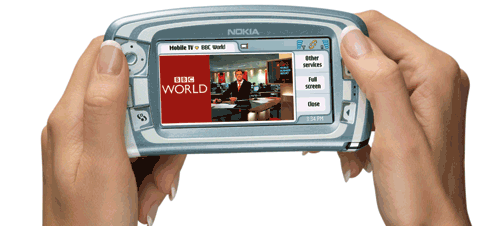
So, when you want to make a voice call you can either tap the telephone icon on-screen then tap the “virtual” number pad which appears, or use the call button on the upper edge of the hardware to see a list of dialled numbers, received calls, and missed calls. In the former case you must attack the screen to make your call, in the latter you can either tap the screen or use the hardware buttons. But in neither case can you make a call using just one hand. The ergonomics for this don’t work. What that means is that during test I couldn’t make a call when I had only one hand free (eg when carrying shopping), and making a call while walking along was a more complicated process than it should be.
The hardware is a bit large to hold to the ear during calls too, though with Bluetooth built-in using a headset is an obvious option. On the plus side the built-in speaker was very loud and we generally found call quality to be excellent.
To be honest, voice calls seem to be a bit of an adjunct as far as the Nokia 7710 is concerned. I’ve already noted the relationship between Nokia’s Series 90 and Series 80 platforms and mentioned that array of programs, hinting that its breadth could be one of the reasons that the 7710 doesn’t quite hit the spot. Let me explain what I mean.
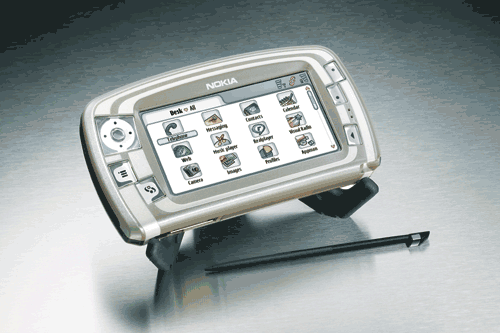
Among the array of applications pre-installed are a word processor and spreadsheet as well as a PowerPoint presentation viewer. These are applications that a professional user might find handy, the document creator has a word count feature, and supports a lot of formatting detail. Documents created are very easily sent as email, text messages, or via Bluetooth to another device simply by using menu options within the application. There is some very good handwriting recognition software built-in too, which is available in a window which also offers a soft keyboard.
The soft keyboard is not restricted to the Documents application, and I wouldn’t mind using it for writing SMS messages or emails, but it’s not good enough for writing longer texts like this review for instance. For that you would need an external keyboard. So professionals might find appeal in the lure of these applications, but difficulty with their actual use.
The multimedia experience is also somewhat mixed. The built-in camera whose lens sits on the back of the hardware lacks a mirror making it impossible to frame photographs that include yourself. It also lacks a flash. You can capture images at resolutions up to 1,152 x 864 and video at up to 17fps with full screen playback at 15fps.
Using the camera is nice and easy – a great user interface feature that I haven’t mentioned before it is that within applications the right edge of the screen is used for three buttons offering quick access to common features. Where the camera is concerned these are dedicated to capture, zooming, and jumping to the saved image library.
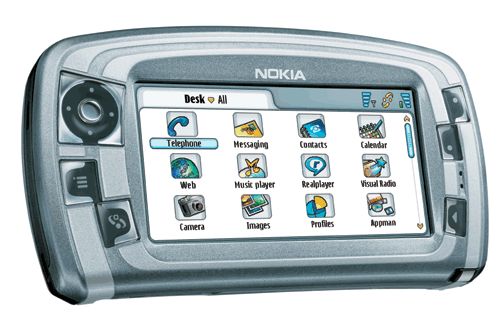
However video playback quality – via RealPlayer – is not very good. The videos I shot at the very highest quality were poor when viewed in full-screen mode as were the provided sample videos. When it comes to music, output to the provided stereo headset is not all it could be and because Nokia uses its Pop-Port connector for this you can’t easily plug in a headset of your own.
The Nokia 7710 has a built in FM receiver with 20 presets, and supports Visual Radio. Visual Radio offers radio broadcasters the chance to send content relating to their audio to devices. Currently there are no services available in the UK but the situation is expected to change in the near future.
One of my most positive experiences with the Nokia 7710 was Web browsing. Widescreen format is entirely suitable for browsing the Web. Using the tappable keypad or handwriting recognition to enter URLs is a delightfully fast and easy operation, and pages themselves can be set to use the full width of the screen. Furthermore the 640 x 320 pixels squeezed into the display mean pages are clear and readable. Nokia lets the experience down by only offering 65,000 colours, though.
I could see myself using the 7710 as a small Web terminal in the home over WiFi – except that Nokia has failed to build Wi-Fi in. Trying to use the Web out of doors I encountered another of the major letdowns with this hardware: the screen is fantastically bright and clear indoors, but in bright sunshine it’s very washed out.
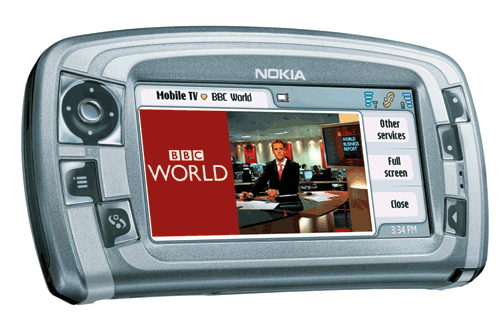
If you’re wondering how you’re supposed to store all the photos and videos you shoot, your music, and other media, you’ll be pleased to know that there is 90MB of built in non volatile memory, and Nokia provides a further 128MB on a MultiMedia Card. The card sits in a slot under the battery cover but you don’t need to remove the battery to swap cards. Nokia also provides its PC Suite software to share data with your desktop computer (Windows only I’m afraid).
Battery life for the 7710 is quoted as between 3.5 and 12 hours of talk, or seven to nine days of standby. That’s quite a wide margin, and with such a large screen to power I was rather concerned the battery life might be short so I decided to run two tests.
In the first I set the display to be at its brightest and by prodding at it every hour forced it to stay always on while I looped MP3 music. I got 4 hours 51 minutes of life, which, if compared to handheld computers, is not too bad at all. In the second test I allowed the screen to dim after ten seconds (the minimum available) and the screen saver to activate after one minute (again the minimum). The screen saver turns off all the screen except a bar 640 pixels wide and 48 pixels tall, and is a power saving measure. I also set the screen to operate at half its full brightness level. Again I looped MP3 music, and in this test I got 16 hours 22 minutes of life, measured over the course of 3 days, with the battery removed between sessions. These figures seem pretty good to me.
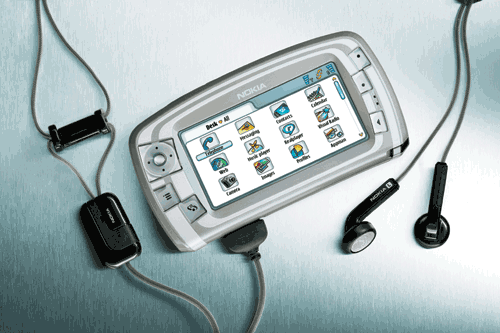
There’s one final point worth making about the Nokia 7710 and that relates to how it handles applications. I found it took between about one and three seconds to load applications the first time. Thereafter their state is retained in memory, and switching back to them involves almost no time lag. The more data an application has to find, the longer it takes to load which means Calendar with a full schedule or Contacts with a large database will always take a while to load when you switch the 7710 on after a period of power down. This is a similar situation to that found that the Nokia 9300 Smartphone and 9500 Communicator, and it is very irritating.
”’Verdict”’
For all the negative comments I’ve made about the 7710 I just can’t help liking it. If innovation were its own reward I’d be scoring this device very highly indeed. But I have to be more practical in my scoring than that, and in the end the device is neither enough of a phone, enough of a multimedia machine nor enough of a PDA to really satisfy. It’s a shame, but there it is, and I just hope Nokia continues to develop the line, because somewhere inside this collection of features and specifications I think there lies a device that really does the business.
”’Note”’
The price quoted is for a Nokia 7710 based on a 12 month Vodafone Anytime 200 contract with a £30 per month line rental.
How we test phones
We test every mobile phone we review thoroughly. We use industry standard tests to compare features properly and we use the phone as our main device over the review period. We’ll always tell you what we find and we never, ever, accept money to review a product.
Trusted Score
Score in detail
-
Usability 7
-
Value 7
-
Features 7

